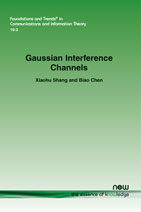Two-User Gaussian Interference Channels: An Information Theoretic Point of View
By Xiaohu Shang, Bell Labs, Alcatel-Lucent, USA, xiaohu.shang@alcatel-lucent.com | Biao Chen, Syracuse University, USA, bichen@syr.edu
Abstract
The purpose of this monograph is to introduce both classic and recent capacity theorems for the two-user Gaussian interference channel including both the single-antenna case and the multiple-antenna case.
This monograph starts with the single antenna case and introduces the Han and Kobayashi achievable rate region and its various subregions. Several capacity outer bounds are then presented, which, together with the achievable rate region, yields several capacity results for the single-antenna Gaussian interference channel, including the capacity region for strong interference and the sum-rate capacity for Z interference, noisy interference, mixed interference and degraded interference.
For the more complex multiple-antenna case, the interference state is no longer determined solely by the interference strength as in the single-antenna case. Instead, the structure of the interference in different multi-dimensional subspaces plays an equally important role. As a result of this multiple-dimensional signaling, new interference states including generally strong, generally noisy and generally mixed interference are introduced to obtain capacity theorems that generalize those for the single-antenna case.
Two-User Gaussian Interference Channels
Two-User Gaussian Interference Channels introduces both classic and recent capacity theorems for the two-user Gaussian interference channel including both the single-antenna and the multiple-antenna cases.
The reader is presented with a comprehensive overview of the single-antenna case. Starting from the basics, including capacity outer bounds and achievable rate region several capacity results for single antenna Gaussian interference channel are described. This section concludes with a full discussion on the capacity region and sum-rate capacity for various types of interference.
The more complex multiple-antenna case uses multiple-dimensional signaling that results in new interference states including generally strong, generally noisy and generally mixed interference are introduced to obtain capacity theorems that generalize those for the single-antenna case.
Two-User Gaussian Interference Channels is essential reading for all researchers and scientists in information theory and communications.
